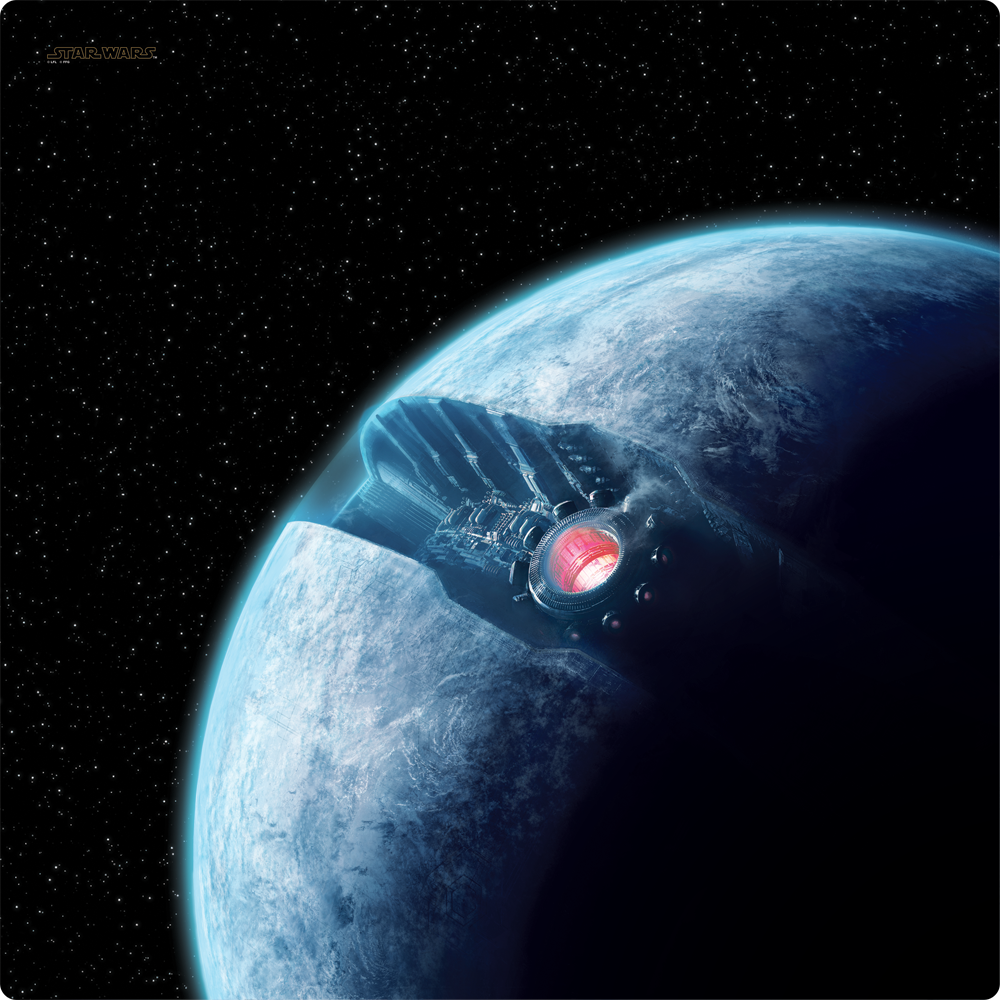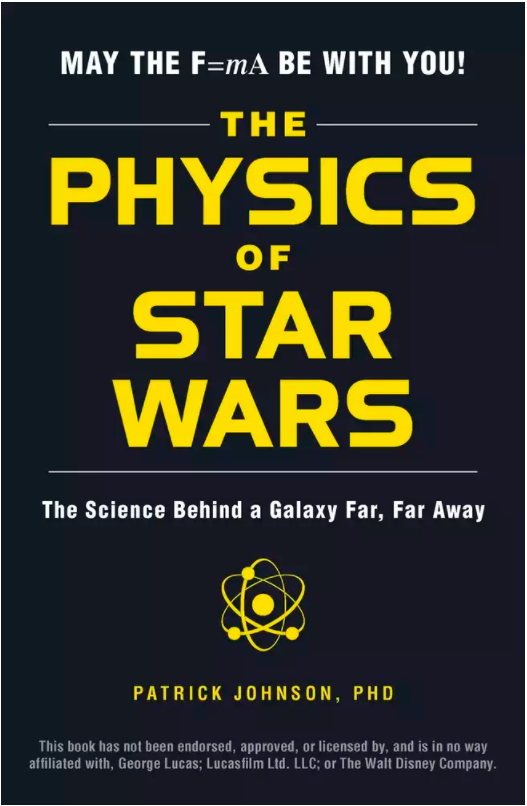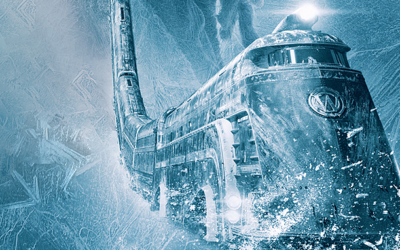Dr. Patrick Johnson can out-nerd any one of you when it comes to Star Wars.
Not only is he a serious Star Wars fan, he’s also an assistant teaching professor at Georgetown University in the Department of Physics. Basically, he’s the guy you hope you get for your physics class. You see, in Dr. Johnson’s class, when it comes time to learn about forces and tension, sample problems may be about Luke Skywalker hanging upside down in a Wampa cave or the force needed to lift an X-Wing out of a swamp on Dagobah as well as any of the more traditional, typical “a block slides down an inclined plane” problems that also double as insomnia cures.
Johnson’s nerddom reached an apex with the recent release of his book, The Physics of Star Wars: The Science Behind a Galaxy Far, Far Away. Make no mistake – Johnson’s isn’t the first, nor will it be the last book that seeks to tie science to Star Wars – the new movies have causes a seeming cottage industry to spring up featuring all sorts of books about the cinematic universe. But Johnson’s stands out due to it’s clarity and accessibility. Each topic gets a short introduction, how the topic is used or seen in the movies, the physics of Star Wars related to that topic, and then the real-world physics. The book is thorough, non-physicsphile friendly, and wonderfully comprehensive (yes, he talks about the Prequels).
I had a chance to talk with Johnson about the book, Star Wars, and using pop culture to connect with his students.
The Science Of: Let’s start with your background – first experience: are you of the original “theater” generation for Star Wars or did you get it on the smaller screen?
Patrick Johnson: I was introduced to the films on VHS by my father. He was a big Star Wars fan, and introduced me when I was very young. Honestly, I was very enthralled by the Ewoks when I first saw the films (I know, I know… I was a kid).
TSO: When did you start applying science to your Star Wars passion? Was this something that started early, or did it come along with the serious academics?
PJ: I started doing this when I first started teaching classes in 2010. I found that my students glaze over when talking about blocks on ramps and lifting heavy objects using pulleys. I found that if I tied physics to pieces of culture, students perked up. I’ve asked questions about the energy the Force can generate and the tension in the cable lifting Luke to the underside of an AT-AT, to name a few.
TSO: That being the case then, was the book something altogether new, or had you been working on the pieces all along, and this gave you a chance to collect them?
PJ: This was altogether new. It was a wonderful connection of passions, but it was not something I had considered until the conversation with the publisher started.
TSO: This is going to sound blunt, but I think it gets to the larger picture of what we all do with this kind of thing – what’s the point of writing a book like this? Let me play the role of the little voice inside your head – shouldn’t you be writing grants?
PJ: It’s a great question! I wrote the book with the intent that it could make physics/science not seem so intimidating. For better or for worse, physics is seen as hard and terrible and so many people I meet say, “I just can’t think like that.” I refuse to believe that some people are just “built” unable to do physics. I hope that this book can make physics exciting and accessible to a general audience. I think physics is really awesome, and I want to – hopefully – bring that excitement to many other people using Star Wars as the way in.
TSO: That said – what’s the best outcome for you and this book? What have you heard from readers, or what could you hear from readers that would put a smile on your face that nothing could ever remove?
PJ: The ideal outcome to me is that young people read it and fall in love with science. In general, I’d love it to be physics that they fall in love with, but I’d be happy with a love of science. In a dream situation, I’d love for non-scientists to read the book and say, “That was written really clearly, and I feel like I want to learn more about physics/science now.”
TSO: Can you talk a little more about how you use Star Wars – or other fiction – in your teaching? What are the upsides and downsides of doing so?
PJ: I use Star Wars – and other pieces of culture like V for Vendetta, sports, Rocky, etc. – to make problems more interesting. As mentioned above, tension in a string can be supporting a block or Luke under an AT-AT. The biggest challenge is that not everybody has seen the films and it won’t make sense to them. I don’t want to leave my students out in my choice of problems. I want the learning experience to be as inclusive as possible.

The Force Awakens’ Starkiller base – one of the toughest things to apply science to (c)Lucasfilm/Disney
TSO: It seems that everyone who looks to use pop culture to explain science always gets the criticism that they’re ruining it, “it’s not supposed to make sense,” or “it’s just a story.” Do you get this, and if so, how do you deal with it?
PJ: I haven’t really gotten it so much, but if I did receive it, my response would be that my book comes from a love of Star Wars. There’s the Feynmann quote which discusses how understanding the rainbow brings more beauty to his viewing of them. I agree with that, but I also feel like my book is never trying to claim, “This is the definitive truth of the matter.” I tried to write the book more from the standpoint of, “This is what we see, and this is one – of possibly many – ways in which that this could happen.” And then I use that to motivate a conversation about science in our universe.
TSO: Looking at things from the story side, should Star Wars put a little more real science into its world? For example, we finally saw the real silence of space in The Last Jedi. Do you think real science would hurt Star Wars, or could it take the idea of making science cool to a much, much larger audience?
PJ: It depends. I’m not a person who requires pure science to be maintained throughout. A space battle in silence would not be that interesting of a film-going experience. I am willing to forgive scientific inaccuracies unless they are crucial to the plot – for instance, if the only way Kylo Ren survived a battle was that all of a sudden, gravity stopped applying to him arbitrarily. I don’t think scientific accuracy is bad in movies, but I think Hollywood’s role is to make an entertaining experience rather than a scientific document.
TSO: That said, what’s your cut-off point for blending fact in with fiction? Has there ever been something where you worked to try to find a real-world physics analogy and finally just had to call it magic and move on?
PJ: (laughs) Not with Star Wars. The novelization of The Force Awakens does an atrocious job trying to describe how Starkiller actually works. It ties in all kinds of excessive stuff that sounds like fluff, but other than that, everything could be explained. I’m not saying magic brain powers actually exist, but we could describe the limitations on human jumping ability or what shooting lightning out of your fingers would be like.
TSO: Let’s hit some specifics about the book – how did you select your topics?
PJ: I watched all of the movies – prequels too – and took notes on things that I thought would be interesting. I came up with about 50 or so topics and ended up writing about 45 of them. Some of them were topics I had in mind without rewatching the films. Others, like the Invisible Hand bridge evacuation scene, was inspired from the rewatching.
TSO: Is there any one that stands out that was particularly difficult for you to make a connection?
PJ: None stand out as super difficult. There were sections that were harder for me to write due to my specific knowledge base prior to writing the book. I mostly stuck to sections that I felt like I had something interesting to say about it. Probably the one that is an example of a harder section is the section on hovercar traffic.
TSO: You bring up a good point there – I think that, thanks to television and other videos, we’re still stuck with the idea of scientists as all-knowing “knowledge banks.” But just for clarity’s sake, even though the book was about the physics of Star Wars, and you’re a physicist, there was some research involved, right?
PJ: Oh man, yes. And I got things wrong in the book. Hopefully nothing tragically wrong – I know of one error I’m especially embarrassed about, but I had to do a lot of reading/watching clips/talking to friends to make sure what I was saying was correct.
TSO: The book was released just before The Last Jedi, so nothing could be included from that film, but still I’ve got to ask – what are you just dying to write about from that?
PJ: The jump to lightspeed through Snoke’s ship, obviously. My gosh, was that a phenomenal scene. There is also the physics of “dropping” bombs on a juggernaut, the Leia being blasted into space scene, the battering ram laser thing, the speeders which used a stabilizing rod – is that actually a good idea or is it just there to make cool red smoke?, the infinity mirror scene. I could go on and on.
TSO: You mentioned it, so I’ll go there – any thoughts on how the bombs were dropped? Would magnetism be able to do it? Gravity?
PJ: (laughs) Not a clue. Possible ways could be magnetism, but they could just make a plastic – or non-magnetic metal ship – and your bombs suck. Similarly, they’d probably be attracted to your ship too which would be a problem. You could launch them out – that’s probably the easiest. I’d be curious to do the math on how big the juggernaut would have to be to have a noticeable gravitational attraction to pull the bombs out.
TSO: Since it seems like there are plenty of ideas – is an expanded volume, or The Physics of Star Wars volume 2 forthcoming?
PJ: That’s not in the works at the moment. I’m in the process of developing a professional website for myself. As part of that site, I plan to have errata, additional thoughts (perhaps on Last Jedi and future films), and other things. Perhaps I’ll collect enough to make another edition or a whole new book.
TSO: I get this question now and then, so I have to ask you too – are you still fun to go to movies or watch TV with?
PJ: (laughs) I certainly hope so. I don’t like to be one of those angry nerds who just complains when things go wrong. As I said earlier, this all comes from a place of love. And when I was writing my sections, I bent over backwards to justify what was said/shown in the films. This includes the Starkiller base, doing the Kessel run in a distance rather than time, and the seismic charges used by Jango Fett in an atmosphere-less area, among others.
TSO: Last question – is Star Wars your only obsession in this direction? There are lots of other franchises around that could be used to get the word about science out – ever look at any of those?
PJ: I am very passionate about A Song of Ice and Fire/Game of Thrones. That relies more heavily on magic, but it would be really interesting to look at things like comets that move very slowly across the sky, a planet whose seasons are inherently unpredictable – or perhaps just too complicated for their science, and others. I think doing this with Harry Potter could also inspire interesting conversations, but again… magic. Also, it was recently suggested to me that the physics of Pokemon would also be very interesting. That’s a piece of culture that I don’t know as much about, but from what I do know, I think it could be really interesting.
The Physics of Star Wars can be found at bookstores or at Amazon and other online booksellers. Along with the preview at Amazon, sample chapters can be found at Wired, Quartz and Popular Science.









